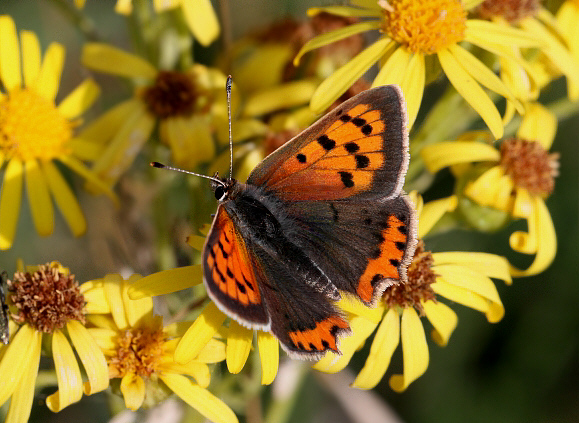 Small Copper Lycaena phlaeas, Hungerford, Berkshire – Adrian Hoskins
Small Copper Lycaena phlaeas, Hungerford, Berkshire – Adrian Hoskins
Introduction
The Small Copper is a very widespread species, occurring in Canada, the eastern United States, the Canary Isles, almost all of Europe including sub-arctic areas of Scandinavia, and across temperate Asia as far east as Japan. It also occurs across much of Africa, from the Atlas mountains and north African grasslands, south to Kenya and Malawi.
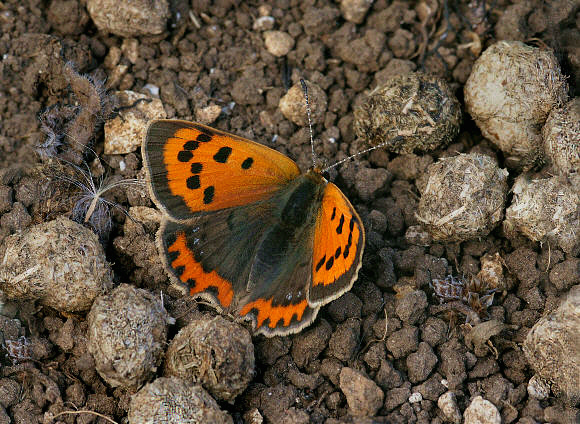
Lycaena phlaeas, 2nd brood female, ab. caeruleapunctata, Stockbridge Down – Adrian Hoskins
Both sexes are subject to variation regarding the size of the black spots on the forewings. 1st brood specimens often have a row of tiny sapphire blue spots on the upperside hindwings – this variety is known as caeruleapunctata. In September 2009, I was lucky to find a beautiful aberration known as schmidtii, which arises periodically in populations following the re-emergence of a recessive gene. No photograph can do justice to this form of the butterfly, whose shining silvery-white wings reflect iridescent hues of green, blue, yellow or orange when seen at certain angles in bright sunlight.
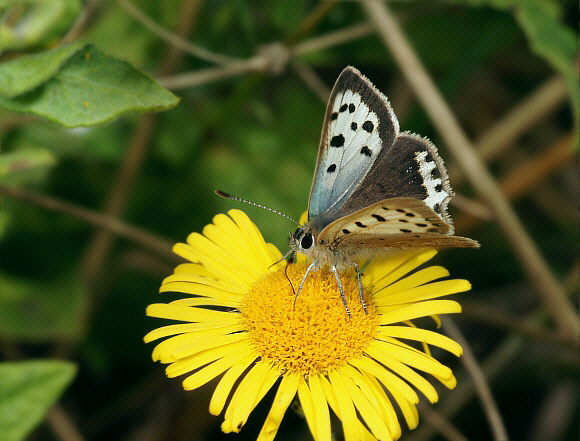
Small Copper Lycaena phlaeas, 3rd brood male, ab. schmidtii, Surrey – Adrian Hoskins
The Small Copper cannot be mistaken for any other British butterfly. In Europe however there are several other Lycaena species – females of hippothoe and tityrus are both similar to phlaeas, so a good field guide is a necessity for less experienced butterfly watchers.
Habitats
In the British Isles the Small Copper occurs in many different habitats including heaths, chalk and limestone grasslands, sand dunes, cliff tops, railway embankments, old quarries, woodland rides and clearings, hay meadows, pastures and almost anywhere else where the larval foodplants grow. The butterflies tend to be localised within each habitat. They usually breed in sheltered hollows, or at the bottom of sunny slopes, where vegetation is sparse, and areas of bare ground are available for basking.
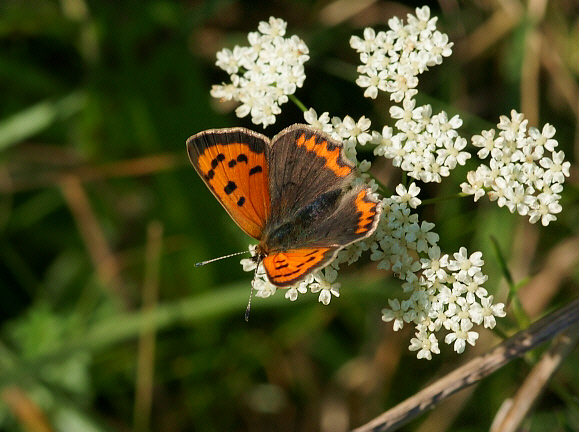 Lycaena phlaeas, 3rd brood male, Stockbridge Down, Hampshire – Adrian Hoskins
Lycaena phlaeas, 3rd brood male, Stockbridge Down, Hampshire – Adrian Hoskins
Lifecycle
In Britain and most of Europe the Small Copper normally produces 2 or 3 broods a year, depending on locality and weather conditions. There is little synchrony between sites however, with the result that the butterfly can be seen at anytime from early April until late October. The 2nd & 3rd broods are always more numerous than the 1st, and can produce populations of 200 or more adults at the best sites in southern England. In northern Scandinavia the species is single-brooded. In the Canary Islands and north Africa it is continuously brooded, producing 5 or more generations a year.
The eggs look like tiny white golf balls, and are normally laid on sheep’s sorrel Rumex acetosella or common sorrel R. acetosa. I have also watched females oviposit on other Rumex species including curled dock crispus, broad-leaved dock obtusifolius, clustered dock conglomeratus and wood dock sanguineus. The plants selected are always in sheltered sunlit positions, often at the base of hills. A female will typically hop about exploring the edges of rabbit scrapes or other areas of bare soil until she finds a suitable plant. She will lay a single egg on the midrib of the upper surface of a leaf, and then move on to search for another plant. Sometimes a particular leaf will attract several different females, or be used on repeat visits by a single female: In October 2009 e.g. I made a search of dock and sorrel leaves at a site in West Sussex. I found that small leaves of clustered dock which had turned red with the approach of autumn had up to 5 eggs laid on each, but that healthy green leaves on the same plants were barren. Furthermore, none of the numerous common sorrel plants on the same sunlit patch of ground bore a single egg.
After laying perhaps a dozen eggs on various plants females go into ‘nectaring mode’, and spend several minutes visiting flowers in the vicinity. This is usually followed by a resting phase during which they bask on vegetation or on bare ground before resuming egg-laying.
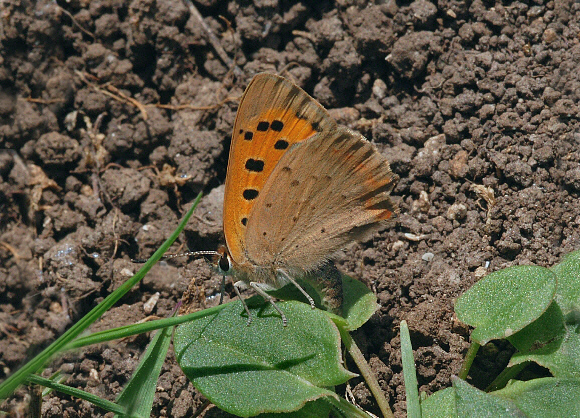 Lycaena phlaeas, ovipositing on sorrel, Stockbridge Down, Hampshire – Adrian Hoskins
Lycaena phlaeas, ovipositing on sorrel, Stockbridge Down, Hampshire – Adrian Hoskins
The larvae are nocturnal. When young they feed on the lower cuticle of the leaves, leaving small characteristic curved grooves which are visible from above. When older they nibble small oval holes out of the leaves, and turning over suspicious looking leaves often reveals the plump green larva beneath. The progeny of the final brood of the season hibernate as 2nd or 3rd instar larvae at the base of the foodplants. These larvae awaken in early spring to resume feeding, and pupate in late March. When the larva when ready to pupate it attaches itself with a silk girdle to a dead leaf at the base of the foodplant. The pupa is pale olive brown, shiny, with darker speckling. The pupal stage lasts about 3 weeks.
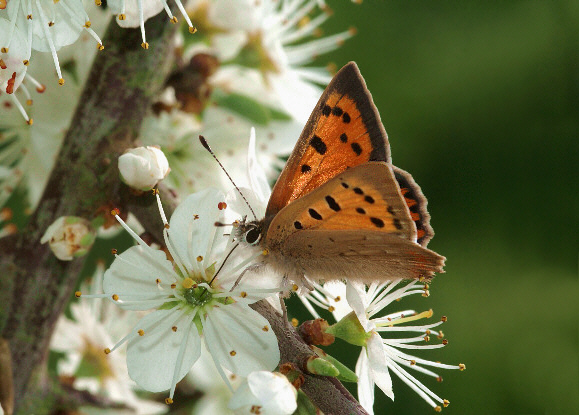 Small Copper Lycaena phlaeas, 1st brood male, Martin Down NNR, Hampshire – Adrian Hoskins
Small Copper Lycaena phlaeas, 1st brood male, Martin Down NNR, Hampshire – Adrian Hoskins
Adult behaviour
In spring the butterflies often bask on bare ground, periodically visiting various wild flowers for nectar. They strongly favour daisies in preference to other nectar sources, but also visit ground ivy, dandelions, buttercups and blackthorn blossom. Summer brood adults visit fleabane, ragwort, yarrow, marjoram and small scabious.
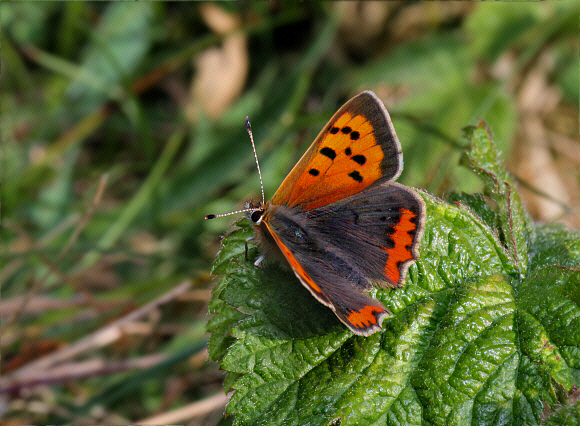 Small Copper Lycaena phlaeas, Magdalen Hill Down, Hampshire � Adrian Hoskins
Small Copper Lycaena phlaeas, Magdalen Hill Down, Hampshire � Adrian Hoskins
Males are territorial, and immediately fly up to chase any small insect which enters their domain. If a male intercepts another male, the pair engage in a frenetic battle, twisting and spiralling in tight circles until one of them throws in the towel and flies off. Often a male intercepts a female that has landed on a flower – if she has already mated she signals her unreceptiveness by rapidly fluttering her half-open wings, while walking rapidly down the stem to the base of the plant. The male usually accepts this rejection signal and flies off in search of another female.
When a virgin female is intercepted, a very rapid zigzag chase takes place, after which the female immediately settles among grasses or sometimes on a bush, where copulation takes place. I have often found copulated Small Coppers in late morning. They are reluctant to fly while copulating and prefer to remain on flower heads or foliage, with the wings of both sexes held half open.
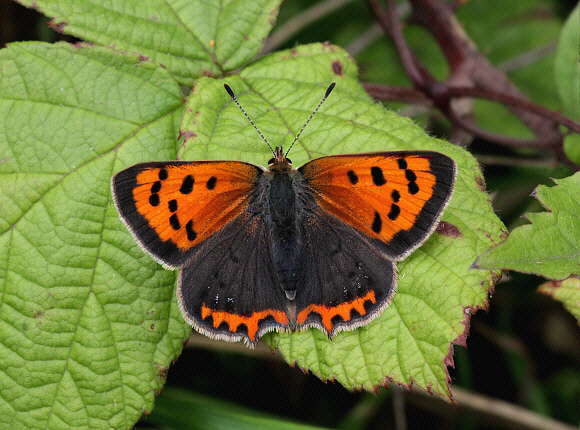 Small Copper Lycaena phlaeas, female, Cissbury Ring, Sussex – Adrian Hoskins
Small Copper Lycaena phlaeas, female, Cissbury Ring, Sussex – Adrian Hoskins
In dull weather and at night the butterflies roost singly on low herbage, grass heads or flowerheads, either sitting upright, or in a head-downwards posture.
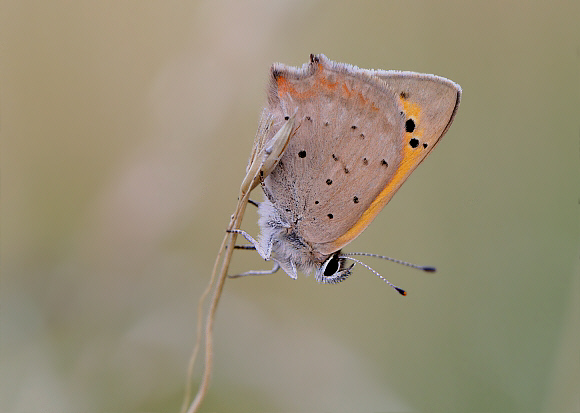 Small Copper Lycaena phlaeas at roost, Hungerford, Berkshire – Adrian Hoskins
Small Copper Lycaena phlaeas at roost, Hungerford, Berkshire – Adrian Hoskins
